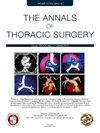Robotic Lung Transplantation: Feasibility, Initial Experience, and 3-Year Outcomes
IF 3.6
2区 医学
Q1 CARDIAC & CARDIOVASCULAR SYSTEMS
引用次数: 0
Abstract
Background
Lung transplantation is performed through clamshell or sternotomy incisions, which may contribute to morbidity and limit patient eligibility. Robotic lung transplantation offers a less-invasive alternative, but data informing treatment choice are limited. This study was therefore designed to evaluate midterm outcomes of robotic and minimally invasive lung transplantation.
Methods
Consecutive patients undergoing robotic or minimally invasive lung transplant (defined by <6-cm minithoracotomy) from October 2021 to February 2025 were included in a prospective registry. The primary end point was 1-year survival. A linear mixed-effects regression model compared postoperative pulmonary function. Median follow-up time was 1.8 years (interquartile range, 1-4 years).
Results
During the study period, 209 lung transplants, including 111 (53.1%) minimally invasive (21 robotic [10%] and 90 nonrobotic [43.1%]), were performed at a single center. Three patients were converted from robotic to nonrobotic approaches. The robotic cohort had similar risk factors and lung allocation scores but longer median waiting list times (50 days vs 22.5 days, P = .02) compared with nonrobotic minimally invasive recipients, and mean ischemic time was 486 minutes vs 406 minutes (P = .02), respectively. There were no significant differences in postoperative ventilator support <48 hours (76.2% vs 75.6%, P = .79), early severe primary graft dysfunction (4.8% vs 8.9%, P = .53), hospital stay (14.1 vs 14.3 days, P = .95), postoperative pulmonary function, or 1-year unadjusted survival (95.0% vs 95.5%, log-rank P = .84) in robotic compared with nonrobotic minimally invasive recipients.
Conclusions
This experience with robotic lung transplantation suggests it is associated with midterm outcomes similar to nonrobotic lung transplantation, despite longer ischemic times.
机器人肺移植:可行性,初步经验和3年的结果。
背景:肺移植是通过蚌壳或胸骨切口进行的,这可能会导致发病率并限制患者的资格。机器人肺移植术提供了一种创伤较小的替代方法,但有关治疗选择的数据却很有限:因此,本研究旨在评估机器人和微创肺移植术的中期疗效:方法:连续接受机器人或微创肺移植手术的患者(根据结果定义):在研究期间,单个中心共进行了 209 例肺部移植手术,其中包括 111 例(53.1%)微创肺移植手术(21 例(10%)机器人肺移植手术和 90 例(43.1%)非机器人肺移植手术):有三名患者从机器人方法转为非机器人方法。机器人队列的风险因素和肺分配评分相似,但与非机器人微创受术者相比,机器人队列的中位等待时间更长(50天对22.5天,P=0.02),平均缺血时间分别为486分钟对406分钟(P=0.02)。与非机器人微创受者相比,机器人微创受者在术后呼吸机支持<48小时(76.2% vs 75.6%,p=0.79)、早期严重原发性移植物功能障碍(4.8% vs 8.9%,p=0.53)、住院时间(14.1天 vs 14.3天,p=0.95)、术后肺功能或1年未调整存活率(95.0% vs 95.5%,log-rank p=0.84)方面均无明显差异:结论:机器人肺移植的经验表明,尽管缺血时间较长,但其中期疗效与非机器人肺移植相似。
本文章由计算机程序翻译,如有差异,请以英文原文为准。
求助全文
约1分钟内获得全文
求助全文
来源期刊

Annals of Thoracic Surgery
医学-呼吸系统
CiteScore
6.40
自引率
13.00%
发文量
1235
审稿时长
42 days
期刊介绍:
The mission of The Annals of Thoracic Surgery is to promote scholarship in cardiothoracic surgery patient care, clinical practice, research, education, and policy. As the official journal of two of the largest American associations in its specialty, this leading monthly enjoys outstanding editorial leadership and maintains rigorous selection standards.
The Annals of Thoracic Surgery features:
• Full-length original articles on clinical advances, current surgical methods, and controversial topics and techniques
• New Technology articles
• Case reports
• "How-to-do-it" features
• Reviews of current literature
• Supplements on symposia
• Commentary pieces and correspondence
• CME
• Online-only case reports, "how-to-do-its", and images in cardiothoracic surgery.
An authoritative, clinically oriented, comprehensive resource, The Annals of Thoracic Surgery is committed to providing a place for all thoracic surgeons to relate experiences which will help improve patient care.
 求助内容:
求助内容: 应助结果提醒方式:
应助结果提醒方式:


